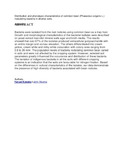| dc.contributor.author | Kawaka, Fanuel | |
| dc.contributor.author | Muoma, John | |
| dc.date.accessioned | 2021-06-03T14:04:23Z | |
| dc.date.available | 2021-06-03T14:04:23Z | |
| dc.date.issued | 2020-08-19 | |
| dc.identifier.uri | https://doi.org/10.1080/09064710.2020.1807595 | |
| dc.identifier.uri | https://www.tandfonline.com/doi/full/10.1080/09064710.2020.1807595 | |
| dc.identifier.uri | http://r-library.mmust.ac.ke/123456789/1582 | |
| dc.description.abstract | Bacteria were isolated from the root nodules using common bean as a trap host. Growth and morphological characteristics of the bacterial isolates were described on yeast extract mannitol mineral salts agar and broth media. The results showed that over 67% of the isolates produced extracellular polysaccharide with an entire margin and convex elevation. The others differentiated into cream yellow, cream white and milky white colouration with colony area ranging from 0.8 to 26 mm2. The population levels of bacteria nodulating common bean varied in soils and were not affected by the cropping system. However, selected soil parameters greatly influenced the occurrence and distribution of these bacteria. The isolation of indigenous bacteria in all the soils with different cropping systems is an indication that the soils are favourable for nitrogen fixation. Based on the differences in cultural characteristics of the isolates, our data demonstrate the presence of high diversity of bacteria associated with bean nodules. | en_US |
| dc.language.iso | en | en_US |
| dc.publisher | Acta Agriculturae Scandinavica, Section B - Soil & Plant Science | en_US |
| dc.subject | Distribution, phenotypic, characteristics, common bean, nodulating, bacteria, diverse,soils. | en_US |
| dc.title | Distribution and phenotypic characteristics of common bean (Phaseolus vulgaris L.) nodulating bacteria in diverse soils. | en_US |
| dc.type | Article | en_US |

